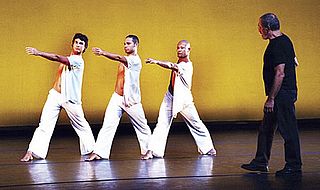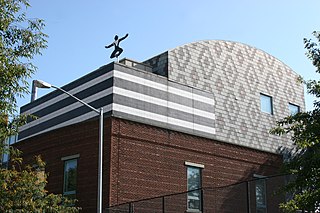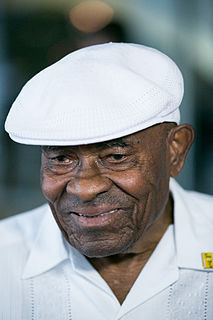
Capoeira is a Brazilian martial art that combines elements of dance, acrobatics, and music. It was practiced by enslaved Africans in Brazil at the beginning of the 16th century. It is known for its acrobatic and complex maneuvers, often involving hands on the ground and inverted kicks. It emphasizes flowing movements rather than fixed stances; the ginga, a rocking step, is usually the focal point of the technique. The most widely accepted origin of the word capoeira comes from the Tupi words ka'a ("forest") paũ ("round"), referring to the areas of low vegetation in the Brazilian interior where fugitive slaves would hide. A practitioner of the art is called a capoeirista.

Jelon Vieira is a Brazilian choreographer and teacher who, in 2000, achieved recognition by New York City's Brazilian Cultural Center as a pioneer in presenting to American audiences the Afro-Brazilian art and dance form, Capoeira.

Dance Theatre of Harlem (DTH) is an American professional ballet company and school based in Harlem, New York City. It was founded in 1969 under the co-directorship of Arthur Mitchell and Karel Shook. Milton Rosenstock served as the company's music director from 1981 to 1992. The DTH is renowned for being both "the first Black classical ballet company", and "the first major ballet company to prioritize Black dancers".

João Oliveira dos Santos, better known as Mestre João Grande, is a Grão-Mestre of the Afro-Brazilian martial art of capoeira angola who has contributed to the spread of this art throughout the world. He was a student of the "father of Angola", Mestre Pastinha, and has an academy in New York City.
Atlanta Ballet is a ballet company, located in Atlanta, Georgia. It is the longest continuously performing ballet company in the United States and the State Ballet of Georgia.

The Brazilian martial art of capoeira, noted for its acrobatic movements and kicks, has often been featured in and influenced popular culture.
Hubbard Street Dance Chicago is America's premier contemporary dance company based in Chicago. Hubbard Street performs in downtown Chicago at the Harris Theater for Music and Dance and at the Edlis Neeson Theater at the Museum of Contemporary Art, Chicago. Hubbard Street also tours nationally and internationally throughout the year.

The Joyce Theater is a 472-seat dance performance venue located in the Chelsea neighborhood of New York City. The building opened in 1941 as the Elgin Theater, a movie house, and was gut-renovated and reconfigured in 1981-82 to reopen as the Joyce Theater. The Joyce is a leading presenter of dance in New York City and nationally.
The Dance Notation Bureau (DNB) is a non-profit organization founded to preserve choreographic works through notating dance scores in Labanotation and collaborating with dance companies to stage reconstructions of those works. Based in New York City, DNB was founded by Helen Priest Rogers, Eve Gentry, Janey Price, and Ann Hutchinson in 1940. It has significant holdings of videotapes, photographs, programs, and production information. Its mission is to advance the art of dance through the use of a system of notation called Labanotation. This allows the dances to be continue to be performed long after the lifetime of the artist.
Northern Ballet, formerly Northern Ballet Theatre, is a dance company based in Leeds, West Yorkshire, England, with a strong repertoire in theatrical dance productions where the emphasis is on story telling as well as classical ballet. The company tours widely across the United Kingdom.

Mystic Ballet is a modern dance company based in Mystic, Connecticut, founded in 1997 by Goran Subotic.

The Philadelphia Dance Company is a professional dance company based in Philadelphia, Pennsylvania, that specializes in contemporary dance. The organization was founded in 1970 by Artistic Director Joan Myers Brown. The company tours both nationally and internationally in addition to their regular appearances locally at the Kimmel Center for the Performing Arts, the Painted Bride Art Center, and other venues in the Philadelphia area. Part of the company's tour schedule is supported by the National Endowment for the Arts' Regional Arts Touring Program and the Pennsylvania Council on the Arts.

The Associação Brasileira de Apoio e Desenvolvimento da Arte-Capoeira (ABADÁ-Capoeira), in English translated as "The Brazilian Association for the Support and Development of the Art of Capoeira," is a nonprofit organization whose purpose is to spread and support Brazilian culture through the practice of capoeira. Founded in 1988 by Mestre Camisa, José Tadeu Carneiro Cardoso, ABADÁ is based in Rio de Janeiro, Brazil. It is one of the largest capoeira organizations in the world with over 41,000 members representing schools throughout every state of Brazil as well as 30 different countries. ABADÁ is distinguished from other capoeira organizations by its worldwide growth as well as its style, standards, and philosophy.

The Ballet East Dance Company (BEDC) is an American modern dance company located in Austin, Texas. Founded by Rodolfo Mendez in 1978, the company presents at least eight staged productions during an annual season. The company often works with nationally recognized choreographers in addition to working with local talent. The BEDC was recently profiled in the National Endowment for the Arts's journal in 2009.

The Oklahoma City Ballet is a professional dance company and school located in Oklahoma City. The company began under the artistic direction of Ballet Russe de Monte Carlo dancers Yvonne Chouteau and Miguel Terekhov in the Science and Arts Foundation building on the Oklahoma City Fairgrounds,

The history of hip-hop dances encompasses the people and events since the late 1960s that have contributed to the development of early hip-hop dance styles, such as uprock, breaking, locking, roboting, boogaloo, and popping. African Americans created uprock and breaking in New York City. African Americans in California created locking, roboting, boogaloo, and popping—collectively referred to as the funk styles. All of these dance styles are different stylistically. They share common ground in their street origins and in their improvisational nature of hip hop.
Donna Uchizono is an American choreographer.

Chicago Dance Crash is an American hip hop/contemporary dance company based in Chicago, Illinois. The company tours year round while sustaining a calendar year ‘season’ of local premiers and commercial work as well as a spring/fall educational outreach program. The company has received widespread critical acclaim while being considered one of the most notable American dance companies to emerge during the first decade of the 2000s.

Eduardo Vilaro is a Cuban-American dancer, choreographer, educator, and artistic director & CEO of Ballet Hispánico. He first joined Ballet Hispánico as a principal dancer in 1985, leaving for Chicago a decade later to further his education and found the Luna Negra Dance Theater, for which he was artistic director. He returned to Ballet Hispánico in 2009 as artistic director, the second since the organization's founding in 1970, and has also served as CEO for the company since 2015 when a reorganization merged these artistic and administrative roles. His vision for Ballet Hispánico draws on the Latin dance traditions and educational outreach set forth by founder Tina Ramirez while responding to the more complex cultural landscape of the 21st century with a greater focus on diversity, inclusion, and community engagement.
Loremil Machado was a teacher and performer of Afro-Brazilian dance. He and fellow dancer Jelon Vieira are considered to be responsible for the introduction of capoeira to the United States. Machado and Vieira, both natives of Bahia, Brazil, came to New York City in 1975, to perform in a production of the play Parto by Brazilian playwright Gilda Grillo and Maria Isabel Barreno. Having decided to stay, they began to teach and perform in venues around the city. Notably, Machado and Vieira performed capoeira demonstrations at public schools in the Bronx. Master capoeira teacher Mestre Acordeon has said "[These] demonstrations by Mestre Jelon [Vieira] and Loremil Machado are considered by many to be responsible for the incorporation of capoeira movements into breakdancing". And author Matthias Röhrig Assunção says "many people believe [their] performances inspired the break dance craze of the 1980s."














